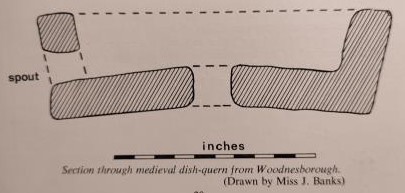Medieval Quernstone Discovered at Woodnesborough
In May 1968, workmen digging a drainage trench at Grove Manor Farm, Wodnesborough, uncovered a large quernstone of rotary type. It came from the silt of a moat close to a private road leading to the farm.
The stone is a complete lower-section made of lava from the Mayen district of Germany. It is of the dish type known only on medieval sites and probably dating from 13th-15th centuries. A slightly smaller example was found at Faver- sham Abbey in 1965 (Excavations at Faversham, 1965, page 61, No. 167) and others have been found in Kent at St. Paul's Cray, St. Augustine's Abbey and perhaps Joydens Wood. It also occurs on a number of other medieval sites in Britain.
The Woodnesborough example is 17.6in. in overall diameter and shows slight signs of wear. Its wall, which is 1.6-1.8in. thick and 3in. high internally (5in. externally), inclines outwards. Its base, about 1.8in. thick and slightly domed, is pierced by a central hole about 2in. wide. It has a single sub-rectangular spout (damaged) 24-34in. wide. The upper-stone (here missing) was normally rotated within this lower-stone to grind corn placed between the two with the resulting flour coming from the spout.
The owner. Mr. J. Vinson, has kindly made the stone available for study. It is at present retained by Mr. Vinson, but it is to be hoped that it may eventually be placed on loan in one of the main Kent museums.

BRIAN PHILP
